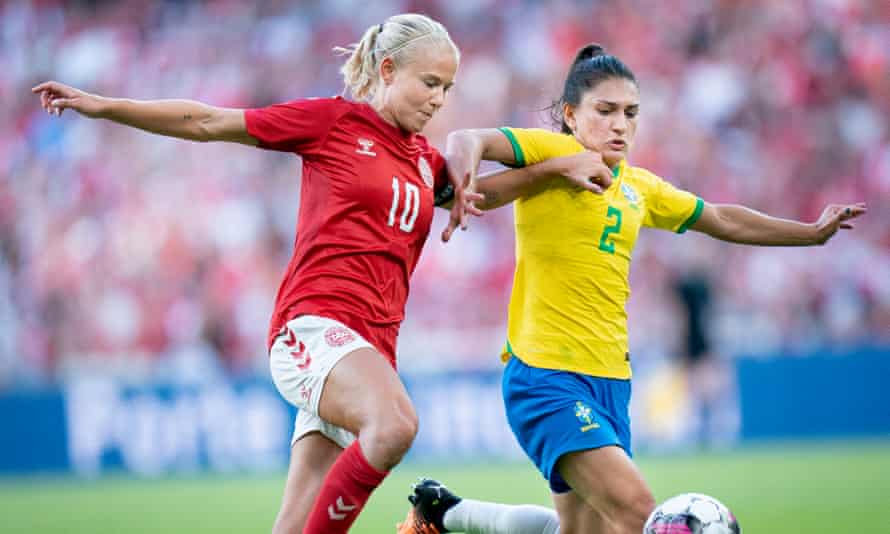A curious sight appeared in the London skyline late on Monday evening. Tower Bridge stands 43 metres high at its centre and for a few moments its entire span was emblazoned with an image of England’s captain, Leah Williamson: bedecked in brilliant England white, a ball at her feet. This was not an isolated phenomenon. Around the same time giant light-show Lionesses started popping up all over the capital: Lucy Bronze on Battersea Power Station, Demi Stokes on the Thames Barrier, Keira Walsh on the façade of the National Gallery.
Coming two days before the biggest women’s sporting event to be held in England, the symbolism was clear enough. For decades, these women – and the thousands before them – have scrapped and striven and suffered for the simple privilege of being seen. For the next 25 days, as Sarina Wiegman’s team and their 15 rivals serve up a feast of football on prime-time television, you may struggle to avoid them. Now – and with the greatest of respect to the Commonwealth Games, Wimbledon and the rest – comes the real jewel of the British sporting summer.
For Williamson and her teammates, the trick will be in reminding themselves that what feels like a climax is just a beginning. This tournament has been five long years in arriving, the flaming beacon on the top of a distant hill that they could always see but never quite touch. For months their diaries have been filled with interviews, promotional engagements, team meetings, analysis sessions, all sharpening to this one point. Well, you made it. Now comes the hard part.
If you are a casual or even a relatively new adherent to this team, you’ve probably heard some vague talk about England winning. You’re probably wondering how much of this is genuine and how much is projection. Let’s clear up that part first. England definitely can win. They have a depth of talent to rival the very best, attacking permutations that boggle the mind, a coach in Wiegman who has been there and done this, six sell-out home crowds waiting for them. They should probably begin as slight favourites.
But none of that gets you over the line by itself. Just ask the French, an unimaginably talented generation of footballers who crashed out of their own World Cup three years ago and who now appear to be quietly imploding before a ball has been kicked. Riven by discord and coached by the mercurial and divisive Corinne Diacre, it says a good deal about France’s squad depth that you can see them challenging even without the brilliant Amandine Henry and Eugénie Le Sommer, stars of Lyon’s Champions League win.
The same goes for a Spain side containing 10 of the Barcelona squad that over the past few years has begun to challenge the way we think about the game. Led by the wise Irene Paredes and with one of the youngest squads in the competition, Spain are stacked with ability and clinical at blowing away weaker sides, but short on tournament pedigree and placed in the toughest group. The late withdrawal of Alexia Putellas is a terrible blow, and will put even more pressure on the likes of Aitana Bonmatí to provide the creative flourish in the final third.

Alongside those three, the main threats should come from northern Europe. Germany, the Netherlands and Norway are former winners, Sweden Olympic silver medallists, Denmark runners-up from 2017 and with plenty of threats beyond the inspirational Pernille Harder. Yes, that is half the field. It’s not fence-sitting; it’s simply a measure of how unfathomably open this tournament is. Italy are pretty good as well. Iceland could spring a shock. Don’t rule out the Swiss. And so on.
Many matches should be played in front of full or nearly full crowds. The selection of stadiums has been the source of some considerable controversy.
The 4,700-capacity Academy Stadium and 8,100-capacity Leigh Sports Village are not a great look when you consider that the smallest venue at next year’s World Cup in Australia and New Zealand will hold 22,000. The demand is there – tickets for the final sold out in an hour, and overall sales will smash all previous records – but don’t blame the organisers. Every major ground in the country was invited by the Football Association to bid for hosting rights. If your club isn’t staging a game, either they didn’t want to or the local authorities failed to play ball.
And yet perhaps the most refreshing aspect of this tournament is how little its success is dependent on a home victory. Even if you take into account Uefa’s recent record on big events, the likelihood of trouble is minuscule, the spectre of empty stadiums already avoided, the quality of the football guaranteed, the audience already in place. This in itself is its own devastating victory. For so much of its history women’s football has been forced to advocate for its own right to exist. Time and energy wasted talking to people who don’t want to listen, fighting against people who want it to fail, arguing for a respect that is always begrudgingly given.
Well, that argument has been won. The misogynists have already lost. And this is the result: a pure football tournament, a pure celebration, a pure space for women to beguile and be beguiled, a space carved out by the toil of the pioneers who came before but not in thrall to history or tradition.
The congregation has been converted. The churches are in place. The doors are about to swing open. Time for these women to clear their throats and belt out a few hymns.
